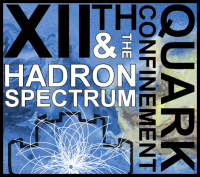Speaker
Description
High-energy peripheral reactions provide an excellent opportunity to study the excitation spectrum of hadrons. The COMPASS experiment at CERN has measured the diffractive scattering of pions to the 3-pion final state with unprecedented statistical precision. Partial wave analysis techniques have been employed to obtain an expansion of the reaction cross section in terms of partial waves with quantum numbers $J^{PC}\,M^\varepsilon$, which is differential in the $3\pi$ invariant mass and the squared transverse momentum (invariant mass squared of the virtual pomeron).
The aim of our analysis is the interpretation of the mass-dependence of the spin-density matrix in terms of short- and long-range interactions using analyticity and unitarity constraints. Using the K-matrix approach, we build the amplitude for scattering of a quasi-two-body final state ($\pi\pi$-subchannnel resonance + pion), and include a unitarization procedure to incorporate non-resonant long-range production processes via pion exchange, i.e. "Deck"-like processes.
The approach is demonstrated on COMPASS data for the $2^{-+}$ sector. We discuss the long standing puzzle about $\pi_2(1670)-\pi_2(1880)$ interplay. Higher excited resonance poles are tested.
Summary
A new method fulfilling unitarity and analyticity constraints to extract resonance poles from $3\pi$ final states
